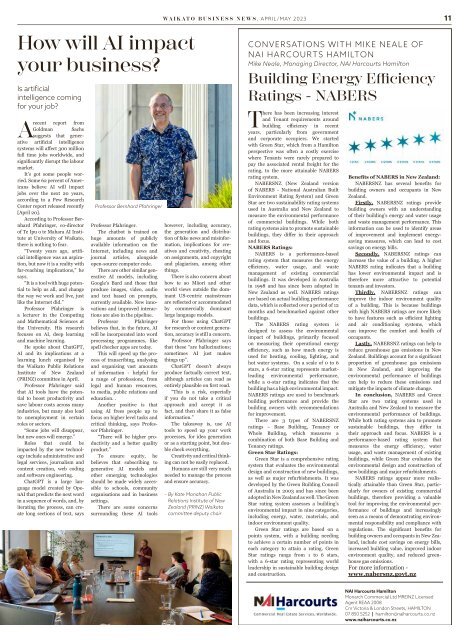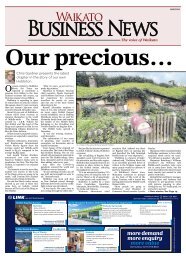Waikato Business News April/May 2023
Waikato Business News has for a quarter of a century been the voice of the region’s business community, a business community with a very real commitment to innovation and an ethos of co-operation.
Waikato Business News has for a quarter of a century been the voice of the region’s business community, a business community with a very real commitment to innovation and an ethos of co-operation.
You also want an ePaper? Increase the reach of your titles
YUMPU automatically turns print PDFs into web optimized ePapers that Google loves.
How will AI impact<br />
your business?<br />
Is artificial<br />
intelligence coming<br />
for your job?<br />
A<br />
recent report from<br />
Goldman Sachs<br />
suggests that generative<br />
artificial intelligence<br />
systems will affect 300 million<br />
full time jobs worldwide, and<br />
significantly disrupt the labour<br />
market.<br />
It’s got some people worried.<br />
Some 62 percent of Americans<br />
believe AI will impact<br />
jobs over the next 20 years,<br />
according to a Pew Research<br />
Center report released recently<br />
[<strong>April</strong> 20].<br />
According to Professor Bernhard<br />
Pfahringer, co-director<br />
of Te Ipu o te Mahara AI Institute<br />
at University of <strong>Waikato</strong>,<br />
there is nothing to fear.<br />
“Twenty years ago, artificial<br />
intelligence was an aspiration,<br />
but now it is a reality with<br />
far-reaching implications,” he<br />
says.<br />
“It is a tool with huge potential<br />
to help us all, and change<br />
the way we work and live, just<br />
like the Internet did.”<br />
Professor Pfahringer is<br />
a lecturer in the Computing<br />
and Mathematical Sciences at<br />
the University. His research<br />
focuses on AI, deep learning<br />
and machine learning.<br />
He spoke about ChatGPT,<br />
AI and its implications at a<br />
learning lunch organised by<br />
the <strong>Waikato</strong> Public Relations<br />
Institute of New Zealand<br />
(PRINZ) committee in <strong>April</strong>.<br />
Professor Pfahringer said<br />
that AI tools have the potential<br />
to boost productivity and<br />
save labour costs across many<br />
industries, but many also lead<br />
to unemployment in certain<br />
roles or sectors.<br />
“Some jobs will disappear,<br />
but new ones will emerge.”<br />
Roles that could be<br />
impacted by the new technology<br />
include administrative and<br />
legal services, journalism and<br />
content creation, web coding<br />
and software engineering.<br />
ChatGPT is a large language<br />
model created by OpenAI<br />
that predicts the next word<br />
in a sequence of words, and, by<br />
iterating the process, can create<br />
long sections of text, says<br />
Professor Bernhard Pfahringer<br />
Professor Pfahringer.<br />
The chatbot is trained on<br />
huge amounts of publicly<br />
available information on the<br />
Internet, including news and<br />
journal articles, alongside<br />
open-source computer code.<br />
There are other similar generative<br />
AI models, including<br />
Google’s Bard and those that<br />
produce images, video, audio<br />
and text based on prompts,<br />
currently available. New innovations<br />
and improved interactions<br />
are also in the pipeline.<br />
Professor Pfahringer<br />
believes that, in the future, AI<br />
will be incorporated into word<br />
processing programmes, like<br />
spell checker apps are today.<br />
This will speed up the process<br />
of transcribing, analysing<br />
and organising vast amounts<br />
of information - helpful for<br />
a range of professions, from<br />
legal and human resources,<br />
to media, public relations and<br />
education. .<br />
Another positive is that<br />
using AI frees people up to<br />
focus on higher level tasks and<br />
critical thinking, says Professor<br />
Pfahringer.<br />
“There will be higher productivity<br />
and a better quality<br />
product.”<br />
To ensure equity, he<br />
believes that subscribing to<br />
generative AI models and<br />
other emerging technologies<br />
should be made widely accessible<br />
to schools, community<br />
organisations and in business<br />
settings.<br />
There are some concerns<br />
surrounding these AI tools<br />
WAIKATO BUSINESS NEWS, APRIL/MAY <strong>2023</strong> 11<br />
however, including accuracy,<br />
the generation and distribution<br />
of fake news and misinformation,<br />
implications for creatives<br />
and creativity, cheating<br />
on assignments, and copyright<br />
and plagiarism, among other<br />
things.<br />
There is also concern about<br />
how te ao Māori and other<br />
world views outside the dominant<br />
US-centric mainstream<br />
are reflected or accommodated<br />
by commercially dominant<br />
large language models.<br />
For those using ChatGPT<br />
for research or content generation,<br />
accuracy is still a concern.<br />
Professor Pfahringer says<br />
that these “are hallucinations;<br />
sometimes AI just makes<br />
things up”.<br />
ChatGPT doesn’t always<br />
produce factually correct text,<br />
although articles can read as<br />
entirely plausible on first read.<br />
“This is a risk, especially<br />
if you do not take a critical<br />
approach and accept it as<br />
fact, and then share it as false<br />
information.”<br />
The takeaway is, use AI<br />
tools to speed up your work<br />
processes, for idea generation<br />
or as a starting point, but double<br />
check everything.<br />
Creativity and critical thinking<br />
can not be easily replaced.<br />
Humans are still very much<br />
needed to manage the process<br />
and ensure accuracy.<br />
– By Kate Monahan Public<br />
Relations Institute of New<br />
Zealand (PRINZ) <strong>Waikato</strong><br />
committee deputy chair<br />
CONVERSATIONS WITH MIKE NEALE OF<br />
NAI HARCOURTS HAMILTON<br />
Mike Neale, Managing Director, NAI Harcourts Hamilton<br />
Building Energy Efficiency<br />
Ratings - NABERS<br />
There has been increasing interest<br />
and Tenant requirements around<br />
building efficiency in recent<br />
years, particularly from government<br />
and corporate occupiers. We started<br />
with Green Star, which from a Hamilton<br />
perspective was often a costly exercise<br />
where Tenants were rarely prepared to<br />
pay the associated rental freight for the<br />
rating, to the more attainable NABERS<br />
rating system.<br />
NABERSNZ (New Zealand version<br />
of NABERS - National Australian Built<br />
Environment Rating System) and Green<br />
Star are two sustainability rating systems<br />
used in Australia and New Zealand to<br />
measure the environmental performance<br />
of commercial buildings. While both<br />
rating systems aim to promote sustainable<br />
buildings, they differ in their approach<br />
and focus.<br />
NABERS Ratings:<br />
NABERS is a performance-based<br />
rating system that measures the energy<br />
efficiency, water usage, and waste<br />
management of existing commercial<br />
buildings. It was developed in Australia<br />
in 1998 and has since been adopted in<br />
New Zealand as well. NABERS ratings<br />
are based on actual building performance<br />
data, which is collected over a period of 12<br />
months and benchmarked against other<br />
buildings.<br />
The NABERS rating system is<br />
designed to assess the environmental<br />
impact of buildings, primarily focused<br />
on measuring their operational energy<br />
efficiency, such as how much energy is<br />
used for heating, cooling, lighting, and<br />
hot water systems. On a scale of 0 to 6<br />
stars, a 6-star rating represents marketleading<br />
environmental performance,<br />
while a 0-star rating indicates that the<br />
building has a high environmental impact.<br />
NABERS ratings are used to benchmark<br />
building performance and provide the<br />
building owners with recommendations<br />
for improvement.<br />
There are 3 types of NABERSNZ<br />
ratings – Base Building, Tenancy or<br />
Whole Building, which measures a<br />
combination of both Base Building and<br />
Tenancy ratings.<br />
Green Star Ratings:<br />
Green Star is a comprehensive rating<br />
system that evaluates the environmental<br />
design and construction of new buildings,<br />
as well as major refurbishments. It was<br />
developed by the Green Building Council<br />
of Australia in 2003 and has since been<br />
adopted in New Zealand as well. The Green<br />
Star rating system assesses a building’s<br />
environmental impact in nine categories,<br />
including energy, water, materials, and<br />
indoor environment quality.<br />
Green Star ratings are based on a<br />
points system, with a building needing<br />
to achieve a certain number of points in<br />
each category to attain a rating. Green<br />
Star ratings range from 1 to 6 stars,<br />
with a 6-star rating representing world<br />
leadership in sustainable building design<br />
and construction.<br />
Benefits of NABERS in New Zealand:<br />
NABERSNZ has several benefits for<br />
building owners and occupants in New<br />
Zealand.<br />
Firstly, NABERSNZ ratings provide<br />
building owners with an understanding<br />
of their building’s energy and water usage<br />
and waste management performance. This<br />
information can be used to identify areas<br />
of improvement and implement energysaving<br />
measures, which can lead to cost<br />
savings on energy bills.<br />
Secondly, NABERSNZ ratings can<br />
increase the value of a building. A higher<br />
NABERS rating indicates that a building<br />
has lower environmental impact and is<br />
therefore more attractive to potential<br />
tenants and investors.<br />
Thirdly, NABERSNZ ratings can<br />
improve the indoor environment quality<br />
of a building. This is because buildings<br />
with high NABERS ratings are more likely<br />
to have features such as efficient lighting<br />
and air conditioning systems, which<br />
can improve the comfort and health of<br />
occupants.<br />
Lastly, NABERSNZ ratings can help to<br />
reduce greenhouse gas emissions in New<br />
Zealand. Buildings account for a significant<br />
proportion of greenhouse gas emissions<br />
in New Zealand, and improving the<br />
environmental performance of buildings<br />
can help to reduce these emissions and<br />
mitigate the impacts of climate change.<br />
In conclusion, NABERS and Green<br />
Star are two rating systems used in<br />
Australia and New Zealand to measure the<br />
environmental performance of buildings.<br />
While both rating systems aim to promote<br />
sustainable buildings, they differ in<br />
their approach and focus. NABERS is a<br />
performance-based rating system that<br />
measures the energy efficiency, water<br />
usage, and waste management of existing<br />
buildings, while Green Star evaluates the<br />
environmental design and construction of<br />
new buildings and major refurbishments.<br />
NABERS ratings appear more realistically<br />
attainable than Green Star, particularly<br />
for owners of existing commercial<br />
buildings, therefore providing a valuable<br />
tool for improving the environmental performance<br />
of buildings and increasingly<br />
seen as a means of demonstrating environmental<br />
responsibility and compliance with<br />
regulations. The significant benefits for<br />
building owners and occupants in New Zealand,<br />
include cost savings on energy bills,<br />
increased building value, improved indoor<br />
environment quality, and reduced greenhouse<br />
gas emissions.<br />
For more information -<br />
www.nabersnz.govt.nz<br />
NAI Harcourts Hamilton<br />
Monarch Commercial Ltd MREINZ Licensed<br />
Agent REAA 2008<br />
Cnr Victoria & London Streets, HAMILTON<br />
07 850 5252 | hamilton@naiharcourts.co.nz<br />
www.naiharcourts.co.nz

















